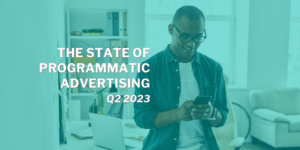
The State of Programmatic Advertising: Q2 2023
In today’s rapidly evolving advertising landscape, programmatic advertising has emerged as a powerful tool that simplifies, automates, and enhances the ad-buying process. Leveraging big data, artificial intelligence, and real-time bidding, programmatic advertising enables precise targeting of specific demographics and audiences. Gone are the days of manual trial and error in selecting ad campaign targeting combinations; programmatic advertising harnesses automation and cutting-edge technology to ensure reaching the right audience at the right time, ultimately leading to improved leads.
Programmatic advertising simplifies, streamlines, and automates the ad-buying decision-making process. It targets specific demographics and audiences through big data, artificial intelligence, and real-time bidding. Thanks to big data, there are millions of potential targeting combinations to choose from when setting up an ad campaign. Attempting to choose them manually involves far too much trial and error, wasting time, money, and effort. Because the process behind it is automated and relies on cutting-edge technologies, programmatic advertising makes it easier to reach the right audience at the right time, resulting in much better leads.
The top factors contributing to the rapid adoption of programmatic advertising include:
- The ability to target specific audiences (far beyond cookie-based technologies)
- The ability to pair advertising inventory with in-depth audience data
- Increasing comfort with programmatic advertising in general
- Enhanced efficiency
2023 and beyond will see an increase in omnichannel programmatic advertising. The global programmatic advertising market grew from $7.31 billion in 2022 to $8.87 billion in 2023 at a compound annual growth rate (CAGR) of 21.4%. Brands are leveraging multiple channels such as mobile, video, display, and even voice ads to reach customers across different devices. In 2013, only 7% were on board, so, a decade later, companies are getting nice returns from the programmatic advertising investments.
Here are three areas of growth for programmatic advertising…
1) Podcast advertising
It seems like everyone and their brother is taking part in the podcast craze, but programmatic podcast activation is still an emerging market. eMarketer predicts that US podcast ad spending will surpass 29% of total digital audio ad spending this year, but only 8.3% of podcast advertising will be bought programmatically in 2023 (up from 3.3% in 2020).
However, as programmatic audio technologies evolve, more and more advertisers will take advantage of the benefits it offers: namely, the ability to place audio ads — in real-time — and to harness the power of advanced targeting, measurement, and optimization technologies to ensure those ads reach key audiences. A 2023 study forecasts programmatic podcast ad spending will triple by 2027. For marketers today, this means that there’s a big opportunity to get in ahead of the curve.
2) Mobile advertising
Mobile programmatic advertising is the automatic buying and selling of mobile ad inventory with software. It replaces the RFP process, in-person negotiation, and the insertion order (I/O) system. The technology makes ad buying more efficient and cheaper for advertisers, because it allows them to access a wide selection of inventory, typically through an ad exchange. It also helps maximize value by finding the best possible price for inventory at any given time.
According to Oberlo, mobile users are projected to reach 6.8 billion by 2023, which means programmatic mobile advertising will surpass desktops by a major haul. From this, one thing is clear: programmatic mobile device advertising will increase.
3) In-app advertising
Cookies are cool, but there’s a lot of room for error and inaccuracy in targeting. Programmatic relies on SDKs to collect device identifiers, which provide the entire foundation for this ad format. These identifiers are consistent and will persist through every stage of the user’s journey from targeting to conversion and this provides a level of accuracy that other ad formats simply can’t compete with.
In-app advertising provides a better consumer experience than display advertising on the mobile web. As almost everyone knows, ads on the mobile web are often compressed and unappealing to smartphone users. In-app ads are scaled to fit the screen and look better, thereby improving overall engagement.
As always though, buyer beware
Programmatic advertising is not without its drawbacks. Advertisers are understandably wary of ad fraud. Fortunately, the machine-learning technologies behind programmatic advertising are capable of identifying fraud patterns and can learn to avoid them. Still, this will likely remain an issue for the foreseeable future. Ad blocking is, as always, a concern, and no simple fix has been developed just yet. With people accessing the Internet via a wider array of devices than ever, tracking users’ activities across multiple devices continues to be a problem too.
Despite concerns, the future of programmatic advertising holds bright, with new technologies and trends set to transform the way advertisers reach their target audiences. Advertisers who stay ahead of the curve and embrace these new trends will be better positioned to succeed in the digital landscape.




